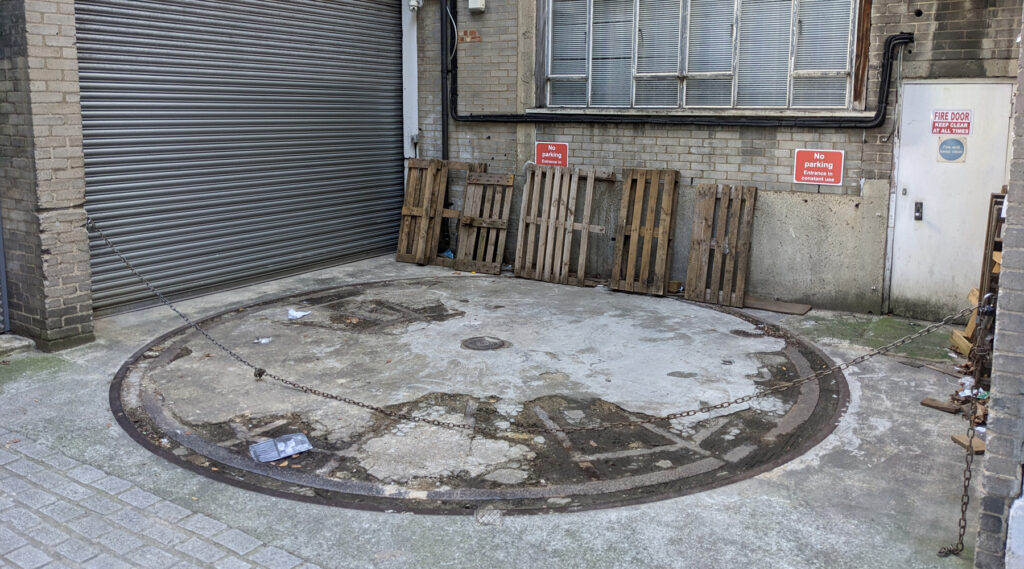This is a narrow alley that sits right next to the main entrance to the BBC’s Broadcasting House, and there’s some unexpected art and heritage down here.
The alley is roughly 200 years old, as it owes its origins to the construction of Regent Street to the south. However, it nearly didn’t exist, as the area looked very different when the fields around here started being developed. A block of housing to the south of the church appears in John Roque’s map of 1746, which was the northernmost point of the Portland estate at the time. The rest to the north, where the church and BBC are today was still fields.
The area was fully developed just 50 years later but looked totally different from how it does today, with regimented blocks of housing and straight streets. As it happens, All Souls’ Place lines up with an alley created at the time, Edward Court, but that’s just a coincidence and not the reason the alley is where it is today.
The whole area was completely rebuilt though in the 1820s to a design by John Nash and the developer James Burton. They cleared the land from Regents Park down to Piccadilly Circus and built Regent Street, and here by the alley, the curving road Langham Place.
Sitting on the corner of the alley is All Souls Church, which was consecrated on 25th November 1824 — and will be marking its bicentenary next year — and an at the time an unnamed alley to the north leading to the backs of some houses. The church was badly damaged in 1940, and it took until 1951 to complete repairs.
Behind the church, to the south side was a school, and on the north side was a row of offices called Langham Chambers, later renamed Egton House.
The second big shake up of the area started in 1928, when the block of houses to the north was demolished to make space for BBC Broadcasting House.
In 2003, the post-war extensions to Broadcasting House on the eastern side were demolished to make way for the modern building we see today with what is still technically a road turned into the entrance courtyard that’s also used for occasional outside broadcasts.
The new eastern wing that was built as part of the works is clad in Portland Stone and dominates the northern side of the alley. Originally named the Egton Wing after the offices that used to be there, it was renamed the John Peel Wing in 2012 to commemorate the late Radio 1 disc jockey.
As you walk into the alley today, the long BBC fills the northern side with a solid stone wall, punctuated only by a goods door and ventilation grills, although if you look up, you can see windows for the offices above.
On your right, directly behind the church on your right is Church House, which was built in 1933-35 to replace the old church vestry and was built to contain the vestries, a parish room, and two flats for church employees. You can see the foundation stone marking the start of works on the new building.
Further down is an interesting building, which looks a lot grander on the other side, but we’re facing the back of the building, so less grand but possibly more interesting. The building is notable though, as it was constructed between 1909-11 as the London Radium Insitute, the first such facility in the UK to make medical use of radium to treat cancer.
The rich would go in via the front entrance on Riding House Street, and the poor would walk down All Souls’ Place and enter via the small door to your right. Plus ça change.
Later used by the NSPCC as their head office, in 2012 it was converted into the Embassy of Algeria, and it was the conversion work that added the two modern garage doors. The mosaic panel above the wider garage was created by Mosaic Restoration to complement the existing mosaic above the smaller door. If you look up, you can see an example of more mosaics above the higher floor windows.
At the far end, the alley is a dead end, with a rear entrance to a shop and another garage door for deliveries to the office block behind.
A notable feature though is the turntable. You often see these inside modern offices for deliveries so that vans can drive in, get turned around and drive out without needing to reverse, it’s rarer now to see a turntable outside the delivery doors, although they used to be far more common at one time. The last one I saw in situ was in Primrose Hill, since been removed.
Sadly, it looks like this one has been out of action for many years, but should be looked after as an important example of post-war office development.
Along with the mosaics, the turntable does though make a short detour down this alley worthwhile.
















So interesting. Thank you, Ian!
The Beebs favourite “reporting from outside” location when nobody wants to walk very far, either that or it’s too much time and hassle to bring the guest in past security.
Very interesting. Thank you, Ian!